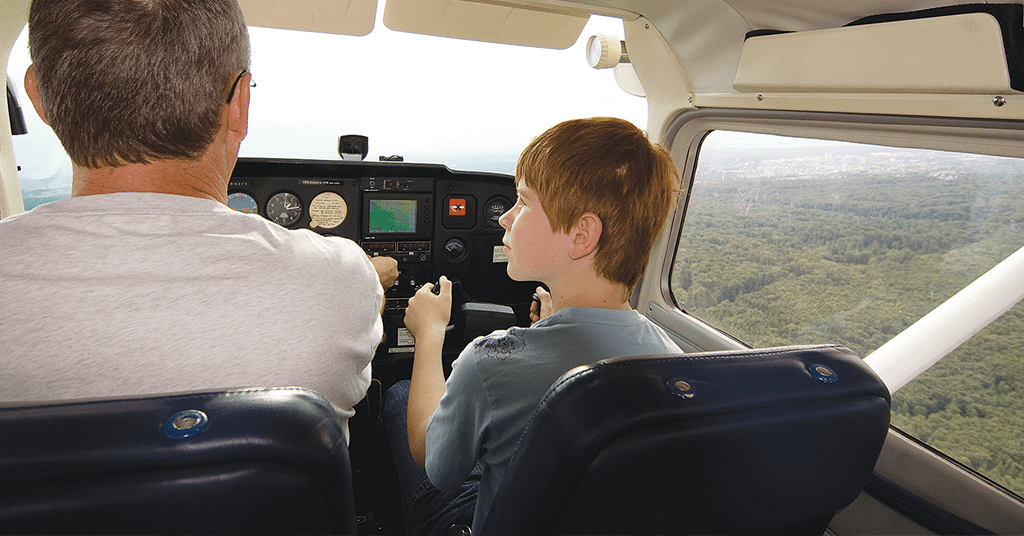By Steven Daun, National Chief Pilot
One of the best things about being with other pilots is finding out what motivated each of them to fly. The only thing even more interesting is finding out why people chose to devote their careers to aviation. This month we asked a few of our long-time employees to give us a glimpse of what motivated them to make their careers in aviation.
Mike Bliss
Chairman of the American Flyers National Safety Board
In 1957, I was 10 years old and sitting in a window seat of a Lockheed Constellation for my first ever airline flight. We were traveling from Toledo, Ohio to Daytona Beach, Florida for Christmas vacation. When those Wright Cyclone engines began rumbling, spitting smoke and fire, I was immediately hooked. The takeoff was absolutely exhilarating, and I was mesmerized looking out the window, watching everything get smaller as we climbed up to and through the clouds.
The stewardess (that’s what they were called back then) must have seen my excitement because after we reached cruising altitude, she came back and said the captain would like to see me in the cockpit. I’d never seen so many dials in one place and was amazed that anyone could possibly understand what it all meant. I don’t remember what was said. I just knew that one day I was going to be a pilot.
Rick Farmer
National Director of Maintenance
Like most people working in the aviation industry, I was drawn to it by my love of airplanes and the dream of one-day flying. Over the years of working with many smart and talented people, I’ve come to realize that this shared passion is what sets the aviation industry apart from others. While people might move around within aviation, it is rare to see anyone leave it entirely.
My aviation career started in the late 90s when I decided to take an intro flight at my local airport. I’ll never forget that flight or the overwhelming feeling that this was something I had to pursue further. Being extremely excited and a little overwhelmed at the amount of information and skills that I would need to master it, I looked forward to the challenge.
I started taking flight lessons every time I had a little spare money and was eventually able to obtain my private pilot’s license in 2000. Although I felt great accomplishment for getting it done, I now understood what everyone meant when they said it was a “license to learn.” Coming from an automotive mechanical background, I wanted to learn as much as I could about the mechanical side of airplanes, which led me to research A&P schools. I believed that being a mechanic would make me a better pilot which would make me a better mechanic. I also hoped that I would be able to find a maintenance position to help me fund the rest of my flight training.
After completing my A&P in 2002, I walked into the American Flyers location in Pompano Beach, Florida with a resume in hand. The manager told me that the company had openings in the mechanic/pilot scholarship program which would allow me to receive flight training as part of my compensation for working as a mechanic on their fleet. The rest is history.
I was able to finish my flight training with American Flyers and during my time as a mechanic in the scholarship program, I realized that I really enjoyed being a part of the maintenance team. My role has changed quite a bit over the years, but one thing that hasn’t changed is my passion for aviation. I’m proud of our maintenance program at American Flyers and the mechanics behind the scenes that are working hard to maintain our standard.
Garry Goddard
Pompano Beach Chief Pilot
During the hot English summer months of late July and early September, my parents would send me to spend my summer holidays with my grandparents. This event took place every year from the age of 5 till 15. My grandparents lived in the Suffolk countryside just outside the town of Bury St Edmunds in a village called Rougham. The garden was large, and the fence line backed onto runway 27 at Rougham Airfield: a decommissioned R.A.F. World War 2 airfield.
Each summer for many years I would sit fascinated at the fence, watching airplanes taking off and landing, keeping a diary of all the aircraft tail numbers. One day during a summer visit, when I was around 12 or 13 years of age, the urge became too much. I climbed over the fence and very carefully wandered around the airfield. I would lie in the tall grass hoping not to be noticed. Each day that summer I would get a little bolder creeping closer and closer to the aircraft until when I thought no one was around I found myself under the wing of a Cessna 152. Imagine my surprise when pulling the door handle, it clicked open. Now I was oblivious to anything other than climbing in and marveling at the dials and gauges whilst manipulating the flight controls. Unaware that I was about to be found out by the irate and ranting owner.
When the dust had settled and the airfield manager discovered my name, my grandfather was called. At first, I thought I was in deep trouble. However, the airfield manager was looking for someone to clean airplanes and wanted permission to ask if I would like to do that. The payment was not monetary but flight lessons. That was the day my aviation career took flight.
Patrick Connell
CFI Academy Lead Instructor
Having been born with a pilot for a father, it is not a surprise I grew up with a deep love and affinity for airplanes. Especially those military types from World War 1 and World War 2.
Before I could even speak, my father would read to me out of WW1 airplane books, specifically the “Harleyford Publishing” books out of the UK from the 1940s and 1950s.
The first word I ever spoke was the name of a French aircraft manufacturer during WW1: “Spad.” The Spad 13 C1, having been made famous by Capt. Eddie Rickenbacker as America’s top-scoring fighter ace in the first world war.
My passion never dimmed for airplanes, and it is just as strong now as ever. Having wanted to be a pilot my entire life, it was my great privilege to do so at age 35. I continued training for commercial, multi-engine, CFI, and CFI-I. To my great joy, it was even more magnificent than I had imagined when I was younger!
I have opted to become a professional flight instructor, as there have been few other things in my life more rewarding than sharing the magic of flight with like-minded individuals. For more than thirty years, American Flyers has given me the opportunity to actually get paid to do something I love, and I am grateful.
Kat Batista
American Flyers Customer Support
Back in the 90s, my friend worked at a national FBO that was a sister company to a major airline. They needed a customer service representative and I needed flight benefits. Well, “needed” might be a strong word on my part, but you know what I mean. I worked there on and off for 5 years. During one of the off years, I worked at an FBO/aircraft maintenance shop in northern Florida where I manufactured GPS and comm-wiring harnesses that mostly went into Bonanzas, Barons, and Citations. While I was there, I took some flight lessons from the local club. The view out of the Cessna’s window was remarkable: wild horses running on Cumberland Island and clusters of hammerhead sharks swimming along miles of white beaches.
One of my co-workers at the FBO was a woman known as Miss Millie. Her husband was a retired navy aircraft mechanic. Their whole marriage, he had been the boss. When she became a pilot, they bought a Beechcraft Musketeer and her husband kept it in beautiful condition. He also gave her all the respect he had given the navy pilots; she was the boss in the airplane. I watched Miss Millie study for and pass her instrument check ride. Throughout my flight training, whenever challenges seemed insurmountable, I thought, “If Miss Millie could do it, so can I.” She was my inspiration to stick with aviation and make a career out of it.
Doc Elliott
American Flyers Technical Writer
At the age of 19, I didn’t have a clue what might be in store for me, so I decided to join the Army to gain knowledge and experience that might point me toward a career. The Army gave me a varied education in many fields that could lead to a career. One of these areas was, believe it or not, how to safely exit an aircraft in flight and land without breaking bones. I was asked many times since then why anyone with a sane mind would do this. My answer was, “The controlled fall was worth the anxiety prior to the actual jump.” As time went by, and after enough coercion, I volunteered to go to jumpmaster school where I flew with total access to the airplane and its Air Force crew. It was that experience that gave me my first idea about being a pilot. When I was discharged, I used my Veteran’s Benefits to take the flight training needed to become a pilot and instructor.
When I completed my flight instructor training at Aviation Training Enterprises at Midway Airport (now American Flyers) in Chicago, Illinois, they also hired me. At this time in 1969, there was a shortage of pilots. However, most airlines required an applicant with at least 1,500 hours. There were several ways to obtain this experience and I selected to do the flight instructor route. What I didn’t know at that time was that I was destined to stay with American Flyers for my career.










